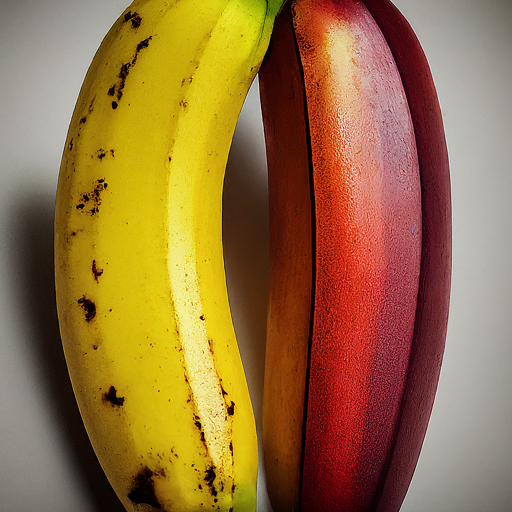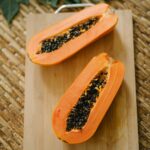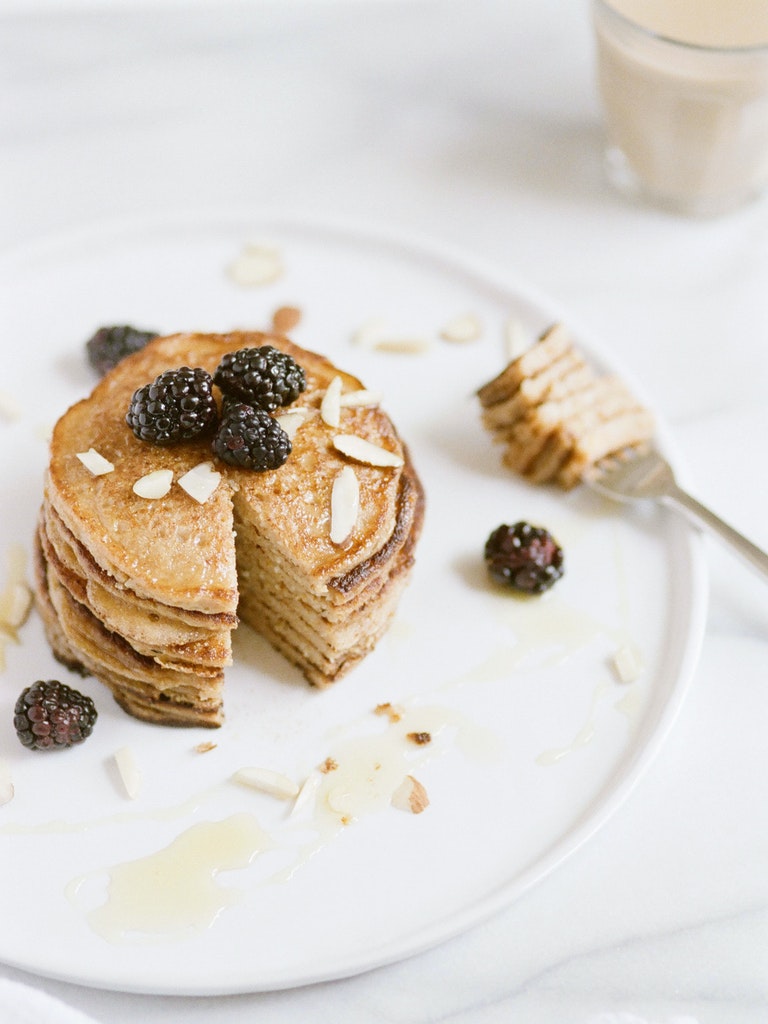What Are Red Bananas?
Have you ever felt like your fruit bowl needs a little more excitement? Imagine a banana that’s not just yellow but comes in a striking shade of red. It tastes sweeter, has a hint of berries, and is packed with more nutrients than the regular bananas you’re used to. Meet the red bananas, the vibrant cousin of the classic yellow banana, that’s here to shake up your fruit game and give a delicious, nutritious twist to your diet. Curious to know more? Let’s dive into why you should consider adding red bananas to your shopping list!
Table of Contents
Reason 1: Nutritional Benefits of Red Bananas
When it comes to nutrition, red bananas are a powerhouse. They are loaded with essential nutrients that can boost your health in various ways. Let’s take a closer look at what makes these fruits so nutritious:
- Rich in Vitamins and Minerals: Red bananas are an excellent source of vitamins C and B6. Vitamin C is crucial for a healthy immune system and acts as an antioxidant, protecting your body from harmful free radicals. Meanwhile, Vitamin B6 is important for brain development and helps the body convert food into energy.
- High in Fiber: Each red banana includes about 4 grams of dietary fiber. This fiber is essential for promoting healthy digestion and preventing constipation. It also helps you feel fuller for longer, which can be beneficial for weight management.
- Packed with Potassium: Like their yellow counterparts, red bananas are rich in potassium. Potassium is essential for maintaining healthy blood pressure levels, supporting muscle activity, and ensuring proper nerve function. A diet rich in potassium can help reduce the risk of cardiovascular diseases.
- Loaded with Antioxidants: Red bananas contain more beta-carotene and lutein than yellow bananas. These antioxidants are vital for eye health and can help protect against conditions like macular degeneration and cataracts. They also support overall skin health and have anti-aging properties.
- Good Source of Iron: Red bananas provide a small but significant amount of iron, which is essential for the production of hemoglobin in the blood. Including red bananas in your diet can help improve blood circulation and prevent anemia.
The nutritional benefits of red bananas make them a superfood worth adding to your daily diet. They not only provide essential vitamins and minerals but also contribute to overall well-being by boosting immunity, supporting heart health, and improving digestion.
| Nutrient | Amount per Medium Red Banana | % of Daily Recommended Intake | Health Benefits |
| Vitamin C | 12 mg | 16% | Boosts immune system, aids in collagen production, enhances iron absorption. |
| Vitamin B6 | 0.4 mg | 20% | Supports brain development, helps convert food into energy, maintains nerve function. |
| Potassium | 400 mg | 9% | Regulates blood pressure, supports heart health, aids muscle function. |
| Dietary Fiber | 3 grams | 10% | Promotes digestive health, maintains cholesterol levels, helps with satiety. |
| Beta-Carotene | 30-40 mcg | – | Acts as an antioxidant, reduces the risk of chronic diseases, supports eye health. |
| Iron | 0.4 mg | 2-3% | Essential for oxygen transport in blood, helps prevent anemia. |
Quick Facts
- Vitamin C: A medium-sized red banana provides 16% of your daily Vitamin C needs, helping to keep your immune system strong and your skin glowing.
- Vitamin B6: With 20% of your daily Vitamin B6 intake, red bananas support brain health and energy metabolism.
- Potassium: Each red banana contains 400 mg of potassium, crucial for maintaining heart health and muscle function.
- Fiber: Packing 3 grams of dietary fiber, red bananas aid in digestion and can help you feel full longer.
- Antioxidants: Red bananas are rich in beta-carotene, which helps protect your body from oxidative stress and supports eye health.
- Iron: Though a modest source, red bananas contribute to your daily iron needs, assisting in preventing fatigue and anemia.
Nutritional Comparison: Red Bananas vs. Other Popular Fruits
| Nutrient | Red Bananas | Yellow Bananas | Apples | Oranges | Strawberries | Blueberries |
| Vitamin C | 12 mg (16% DV) | 10 mg (10% DV) | 8.4 mg (9% DV) | 70 mg (78% DV) | 59 mg (65% DV) | 14.4 mg (16% DV) |
| Vitamin B6 | 0.4 mg (20% DV) | 0.4 mg (20% DV) | 0.04 mg (2% DV) | 0.1 mg (5% DV) | 0.05 mg (3% DV) | 0.1 mg (5% DV) |
| Potassium | 400 mg (9% DV) | 422 mg (9% DV) | 195 mg (4% DV) | 237 mg (5% DV) | 233 mg (5% DV) | 114 mg (2% DV) |
| Fiber | 3 grams (10% DV) | 3 grams (10% DV) | 4.4 grams (16% DV) | 3.1 grams (11% DV) | 3 grams (11% DV) | 3.6 grams (13% DV) |
| Antioxidants | Beta-carotene, Vitamin C | Vitamin C | Quercetin, Vitamin C | Vitamin C, flavonoids | Vitamin C, anthocyanins | Anthocyanins, Vitamin C |
Quick Facts:
- Red Bananas vs. Blueberries: Red bananas contain more potassium and Vitamin B6, whereas blueberries excel in antioxidants like anthocyanins

- Red Bananas vs. Yellow Bananas: Red bananas contain similar amounts of Vitamin B6 and potassium but offer more Vitamin C and unique beta-carotene antioxidants.
- Red Bananas vs. Apples: Red bananas have double the potassium and significantly more Vitamin B6 than apples. Apples have slightly more fiber.
- Red Bananas vs. Oranges: While oranges have a much higher Vitamin C content, red bananas provide more Vitamin B6 and potassium.
- Red Bananas vs. Strawberries: Both are rich in antioxidants, but red bananas provide more potassium and Vitamin B6, while strawberries have a higher Vitamin C content.
Reason 2: The Unique Flavor Profile of Red Bananas
Have you ever wondered, “What do red bananas taste like?” If you’re curious about trying them, you’re in for a delightful surprise. Red bananas offer a unique and delicious flavor profile that sets them apart from regular yellow bananas.
- Sweet and Creamy: Red bananas are known for their sweet and creamy taste. They have a softer texture than yellow bananas, making them perfect for blending into smoothies or mashing into recipes. Their sweetness is often compared to that of a ripe yellow banana but with a creamier consistency.
- Hints of Berry and Mango: One of the most distinct features of red bananas is their subtle hint of raspberry or mango flavor. This berry-like undertone gives red bananas a unique taste that can add a refreshing twist to various dishes and desserts.
- Less Starchy, More Flavorful: Unlike yellow bananas, which can sometimes have a starchy taste when not fully ripe, red bananas are naturally sweet and flavorful even when they are not completely ripe. This makes them an excellent option for those who prefer a sweeter banana without the starchiness.
The unique flavor of red bananas makes them a favorite among those who enjoy exploring new tastes. Whether you eat them on their own, add them to fruit salads, or use them in baking, red bananas can elevate the flavor of any dish.
How Are Red Bananas Different from Yellow Bananas?
Red bananas and yellow bananas may belong to the same family, but they offer distinct experiences when it comes to taste, texture, and appearance. Here’s a quick breakdown to highlight their differences:
| Feature | Red Bananas | Yellow Bananas |
| Taste | Sweet with berry and mango hints | Mild, straightforward sweetness |
| Texture | Soft, creamy, and velvety | Firmer and slightly starchy |
| Appearance | Reddish-purple skin; light peach or pinkish flesh | Bright yellow skin; pale off-white flesh |

Quick Facts
- Yellow Bananas: Known for their mild and neutral sweetness, with a firmer texture that works well in a variety of dishes. Their classic yellow skin and off-white flesh are a familiar sight in every fruit bowl.
- Red Bananas: Offer a sweet, creamy taste with a hint of berries. Their soft texture is perfect for smoothies and desserts. They stand out with their vibrant red skin and slightly pinkish flesh.
Reason 3: Versatility in Cooking and Baking
Red bananas are not just delicious; they are incredibly versatile in the kitchen. Whether you’re a professional chef or a home cook, red bananas can be incorporated into a variety of recipes. Here’s how to eat red bananas in different dishes:
- Smoothies and Shakes: Due to their natural sweetness and creamy texture, red bananas are perfect for smoothies and shakes. Blend them with other fruits like strawberries or mangoes, add a splash of yogurt or almond milk, and you have a delicious, nutrient-packed drink.
- Baking: Red bananas can be used as a substitute for yellow bananas in many baking recipes. Think banana bread, muffins, pancakes, and cakes. Their sweet and slightly berry-like flavor adds an extra layer of taste to baked goods, making them even more delicious.
- Topping for Breakfast: Sliced red bananas make a great addition to your morning cereal, oatmeal, or yogurt. They provide natural sweetness and a boost of nutrition to start your day on a healthy note.
- Desserts: Red bananas can be used in a variety of desserts, such as fruit salads, parfaits, and even ice cream. Their unique flavor pairs well with chocolate, coconut, and honey, making them a versatile ingredient for many sweet treats.
- Savory Dishes: Don’t be surprised to see red bananas in savory dishes. In some cuisines, red bananas are used in curries and stews to add a sweet and tangy flavor. They can also be grilled or roasted as a side dish.
Certainly! Here are a few simple and delicious recipes featuring red bananas that you can incorporate into your diet:
Red Banana Recipes Chart
| Recipe | Ingredients | Instructions |
| Red Banana Smoothie | – 2 ripe red bananas – 1 cup almond milk – 1 tbsp honey – 1/2 cup Greek yogurt – 1/2 tsp vanilla extract – Ice cubes (optional) | 1. Peel and slice bananas. 2. Blend all ingredients until smooth. 3. Add ice if desired. 4. Serve immediately. |
| Red Banana Pancakes | – 2 ripe red bananas – 1 cup flour – 1 tbsp sugar – 1 tbsp baking powder – 1/2 tsp salt – 1 egg – 1 cup milk – 2 tbsp melted butter | 1. Mash bananas. 2. Mix flour, sugar, baking powder, and salt. 3. Whisk egg, milk, and butter. 4. Combine with dry ingredients and fold in bananas. 5. Cook pancakes in a skillet until golden. |
| Red Banana Muffins | – 3 ripe red bananas – 1 1/2 cups flour – 1/2 cup sugar – 1/4 cup brown sugar – 1 tsp baking powder – 1/2 tsp baking soda – 1/4 tsp salt – 1/2 cup melted butter – 2 eggs – 1/2 tsp vanilla extract | 1. Preheat oven to 350°F (175°C) and line muffin tin. 2. Mash bananas. 3. Mix flour, sugars, baking powder, baking soda, and salt. 4. Whisk butter, eggs, and vanilla, then fold in bananas. 5. Divide batter and bake for 18-20 minutes. |
| Red Banana Oatmeal | – 1 cup rolled oats – 2 cups milk – 2 ripe red bananas – 1 tbsp honey – 1/2 tsp cinnamon – A pinch of salt | 1. Cook oats, milk, and salt in saucepan. 2. Slice bananas. 3. Stir bananas, honey, and cinnamon into oats. 4. Cook until oats are done. 5. Serve warm. |

Quick Tips:
- Oatmeal: Garnish with nuts or a dollop of yogurt.
- Smoothie: Add spinach or chia seeds for extra nutrients.
- Pancakes: Top with maple syrup or yogurt.
- Muffins: Mix in chocolate chips or nuts.
These recipes make it easy to enjoy the unique flavor and nutritional benefits of red bananas in a variety of dishes.
The versatility of red bananas in cooking and baking makes them a fantastic ingredient to experiment with. Whether you’re looking to make a healthy smoothie or bake a batch of delicious muffins, red bananas can add flavor and nutrition to your recipes.
GET IN TOUCH
“Want more yummy recipes with red bananas?
Reason 4: Health Benefits of Red Bananas
Red bananas aren’t just a pretty face in the fruit aisle they pack a punch when it comes to health benefits! Let’s dive into what makes these vibrant fruits so special and address any concerns you might have.
🌟 Top Health Benefits of Red Bananas
1. Packed with Vitamin C: Red bananas are a powerhouse of Vitamin C, essential for boosting your immune system and keeping your skin glowing. Research from the Journal of Food Science and Technology shows that red bananas have even more Vitamin C than their yellow counterparts, giving you an extra dose of this vital nutrient. (Journal of Food Science and Technology)
2. Heart Health Hero: Looking to keep your heart in top shape? Red bananas are rich in potassium, which helps regulate blood pressure and reduce stroke risk. The American Heart Association highlights that potassium is key for heart health, making red bananas a delicious way to support your cardiovascular system. (American Heart Association)
3. Vision Booster: Thanks to their beta-carotene content, red bananas are great for your eyes. Beta-carotene, which converts to Vitamin A, supports healthy vision and a strong immune system. According to the Journal of Clinical Nutrition, this nutrient is crucial for maintaining eye health and overall well-being. (Journal of Clinical Nutrition)
🔍 Addressing Common Concerns
🍌 Sugar Content: Worried about the sugar in red bananas? While they do have natural sugars, they’re also rich in fiber, which helps regulate blood sugar levels. The American Diabetes Association assures us that fruits, including bananas, can be part of a balanced diet for managing diabetes. (American Diabetes Association)
⚠️ Allergy Alert: Banana allergies are rare but possible. Symptoms might include itching or digestive issues. If you suspect an allergy, consult a healthcare professional. The American College of Allergy, Asthma, and Immunology provides valuable resources for managing food allergies. (American College of Allergy, Asthma, and Immunology)
🍽️ Ripeness and Sugar Levels: Fully ripe red bananas have higher sugar content, but they’re still a nutrient-dense choice. Moderation is key, and integrating them into a balanced diet can help you enjoy their benefits without overdoing it. The International Journal of Food Sciences and Nutrition supports the idea of including fruits as part of a healthy eating plan. (International Journal of Food Sciences and Nutrition)
Culinary Traditions Featuring Red Bananas
1. Tropical Cuisine: India and Sri Lanka
In India and Sri Lanka, red bananas, often referred to as “red Abyssinian bananas,” are used in both savory and sweet dishes. They are particularly popular in traditional dishes and desserts.
- India: In Indian cuisine, red bananas are used to make a variety of sweets and snacks. One popular dish is “Banana Halwa,” where ripe red bananas are cooked with ghee (clarified butter), sugar, and cardamom to create a rich, flavorful dessert. Red bananas are also used in “Pooja offerings” during religious ceremonies, adding a sweet and unique flavor to traditional rituals.
- Sri Lanka: In Sri Lankan cuisine, red bananas are often added to “Curry” recipes. They are cooked with spices and coconut milk to create a sweet and spicy dish that complements savory curries. Additionally, “Red Banana Fritters” are a popular snack, where the bananas are deep-fried in a batter, resulting in a crispy, sweet treat.
2. Latin American Cuisine: Colombia and Venezuela
In Colombia and Venezuela, red bananas are known for their versatility and are used in various dishes.
- Colombia: In Colombian cuisine, red bananas are often featured in “Bocadillo,” a traditional sweet treat made from guava paste and red bananas. This dish combines the sweet flavors of both fruits, creating a delightful dessert. Red bananas are also used in “Arepas” with a twist, where they are mashed and added to the dough, giving the arepas a subtle sweetness.
- Venezuela: Venezuelan cuisine includes “Tostones,” where red bananas are sliced and fried until crispy. These crispy banana chips are often served as a side dish or snack, offering a unique twist on traditional plantain tostones.
3. African Cuisine: Uganda and Tanzania
In Uganda and Tanzania, red bananas play a significant role in traditional dishes, adding a sweet and unique flavor.
- Uganda: In Ugandan cuisine, red bananas are used in “Matoke,” a popular dish made from steamed green bananas. Red bananas are sometimes added to the stew, providing a sweet contrast to the savory flavors. Additionally, they are used in “Banana Beer,” a traditional fermented beverage that incorporates red bananas for added sweetness.
- Tanzania: In Tanzania, red bananas are used in “Kaimati,” a traditional sweet dumpling made with bananas, flour, and spices. These sweet dumplings are often enjoyed as a dessert or snack and highlight the versatility of red bananas in Tanzanian cuisine.
4. Pacific Islands: Fiji and Samoa
In the Pacific Islands, red bananas are a staple in local diets and are used in a variety of dishes.
- Fiji: In Fijian cuisine, red bananas are used in “Rourou,” a traditional dish made with taro leaves and coconut milk. The bananas add a subtle sweetness to the dish, complementing the rich flavors of the coconut milk and taro.
- Samoa: In Samoan cuisine, red bananas are used in “Pani Popo,” a sweet bread roll made with coconut milk and sugar. The red bananas are often added to the dough or used as a filling, giving the bread a unique, sweet flavor.
When Are Red Bananas Ripe?
Knowing when red bananas are ripe is key to enjoying their full flavor and nutritional benefits. Red bananas are typically ripe when their skin turns a deep red or purple color and they have a slight give when gently squeezed. Unlike yellow bananas, which are best when they have a few brown spots, red bananas should be soft but not mushy. If the bananas are still firm and the skin is a bright red, they may need a few more days to ripen. Store them at room temperature and avoid refrigerating them until they are fully ripe, as the cold can interfere with the ripening process.
Why You Should Try Red Bananas
Red bananas are a unique and delicious fruit that deserve a spot in your kitchen. From their impressive nutritional profile to their sweet and creamy taste, there are plenty of reasons to give red bananas a try. They are not only a tasty treat but also a versatile ingredient that can be used in a variety of dishes, both sweet and savory. Moreover, the health benefits of red bananas make them a valuable addition to your diet, supporting heart health, boosting the immune system, and promoting healthy digestion.
So, the next time you spot red bananas at your local market, don’t hesitate to pick up a bunch. Experiment with them in your favorite recipes or enjoy them on their own. Once you taste their unique flavor and experience their health benefits, you’ll be glad you tried red bananas!
FAQs about Red Bananas
- What are red bananas?
- Red bananas are a variety of banana with reddish-purple skin, known for their sweet, creamy flavor and unique berry-like taste.
- What do red bananas taste like?
- They taste sweet and creamy, with hints of raspberry or mango, making them slightly different from yellow bananas.
- How do you eat red bananas?
- You can eat red bananas raw, just like yellow bananas. They can also be added to smoothies, baked goods, or used as a topping for cereals and desserts.
- When are red bananas ripe?
- Red bananas are ripe when their skin turns deep red or purple and they have a slight give when squeezed. They should be soft but not mushy.
- What are the nutritional benefits of red bananas?
- Red bananas are rich in vitamins C and B6, potassium, fiber, and antioxidants, making them great for boosting immunity, heart health, and digestion.
- Can red bananas be used in cooking and baking?
- Yes, red bananas are versatile and can be used in smoothies, baking (like banana bread and muffins), or even grilled for savory dishes.
- What is a red banana plant?
- A red banana plant is the tree that produces red bananas. It looks similar to the yellow banana tree but may have red-tinted stems and leaves.
- Are red bananas healthier than yellow bananas?
- Both are nutritious, but red bananas have more beta-carotene and certain antioxidants, which can offer additional health benefits.
- Where can I buy red bananas?
- Red bananas can be found in specialty grocery stores, Asian markets, or health food stores. They may also be available at farmers’ markets.
- Can red bananas be refrigerated?
- It’s best to store red bananas at room temperature until they are ripe. Once ripe, you can refrigerate them to prolong their freshness, but avoid refrigerating unripe red bananas as it can interfere with the ripening process.
These FAQs cover the basic queries about red bananas, offering quick insights into their characteristics, uses, and benefits.
GET IN TOUCH
Discover the vibrant benefits of red bananas
try them today and share your delicious creations with us!





